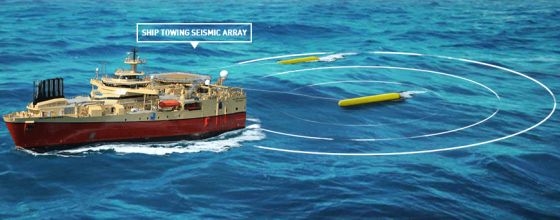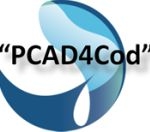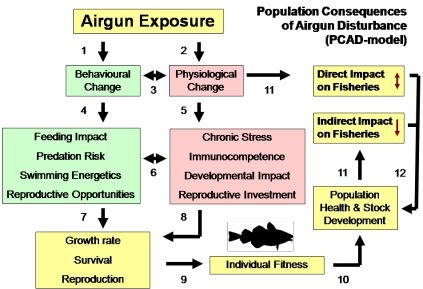Start of new sound impact project on fish
On the 1st of October a new project funded by the Joint Industry Programme (JIP) started at the IBL on the potentially negative effects of sound on fish. Behavioural biologist and bioacoustic specialist Dr. Hans Slabbekoorn leads the international research team.
Sound exposure during seismic surveys at sea can have dramatic effects on fish that are nearby the airgun explosions. The sonic screening of the sea bottom can take weeks or months and may happen 24/7. Fish at close proximity risk becoming deaf temporarily and in extreme cases death. Less dramatic are changes in behaviour, but they may apply to many more fishes present within a much larger area. Consequently, this should be a concern in terms of conservation and fisheries interest.

“PCAD4Cod”

The current project start concerns a theoretical study (Phase 1) into the effects of airgun exposure on fish. The aim is to evaluate the current state of the art with respect to all critical parameters and transfer functions for a fully developed Population Consequences of Acoustic Disturbance (PCAD) model (see figure). As the cod (Gadus morhua) is selected as model species, the project is also referred to as “PCAD4Cod”.
As part of the process, a multi-day workshop, in January at the Lorentz Center in Leiden, will bring together experts in the field of PCAD, environmental impact assessment, underwater acoustics, various types of modelling, fish behaviour and physiology, and fisheries and stock development. The outcome of the exploration will yield a report that will provide insight into what information is currently lacking and how the JIP can best invest into subsequent research efforts (Phase 2).

A flow-chart of the Population Consequences of Acoustic Disturbance model concept tailored to airgun exposure. Direct impact on fisheries is determined by positive or negative changes in catch rate due to fish movements during and after a seismic survey. Indirect impact on fisheries is affected by behavioural (green) and physiological (pink) changes and their potentially negative effects for individual fitness, population health and stock development. Transfer functions that require critical evaluation are numbered 1-12.
JIP for sustainable exploitation
The Joint Industry Programme has a special E&P SOUND & MARINE LIFE programme to support research that aims at increasing our understanding of the effect of sound on marine life generated by oil and gas exploration and production activity. The research should help 1) governments make regulatory decisions based on the best science and 2) industry develop effective mitigation strategies. This collaboration between academia and industry should benefit scientific progress as well as the potential for sustainable exploitation of natural resources to fulfil the energy demands of people around the world.
Links
PCAD4Cod workshop website at the Lorentz center
JIP E&P SOUND & MARINE LIFE website
Cod information on
Wikipedia
